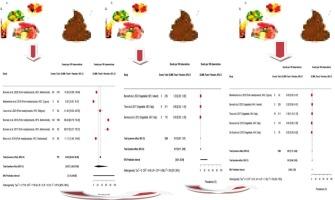Prevalence of Hepatitis A and E viruses in ready-to-eat foods: A meta-analysis
IF 8
1区 农林科学
Q1 FOOD SCIENCE & TECHNOLOGY
引用次数: 0
Abstract
The presence of Hepatitis A (HAV) and Hepatitis E (HEV) viruses in ready-to-eat foods (RTEFs) poses significant public health risk. The incidence of HEV in plant-based RTEFs particularly represents another emerging public health concern. There is a need for effective decontamination strategies to halt HAV and HEV exposure via RTEFs. The present study aimed at assessing the prevalence of foodborne HAV and HEV in RTEFs. A total of 2089 HAV/HEV-RTEFs related data from four integrated repositories was fitted to a mixed-effects model to estimate HAV and HEV prevalence. The prevalence of HEV in pork RTEFs was 22.67 % (95 %CI: 3.96–67.60; I2 = 97.2 %, 95.6–98.2, p < 0.0001) and 0.71 % (0.17–2.95, I2 = 0.0 %, 0.0 %–89.6 %; p = 0.66) in vegetable-based RTEFs. HAV prevalence in vegetable-based and meat-based RTEFs was 1.67 % (0.94–2.95; I2 = 0 %, 0.0–79, p = 1) and 0 %, respectively. In conclusion, the analysis suggests that 22.67 % of RTE pork products carried HEV, highlighting a possible health risk and the need for effective decontamination measures. Meanwhile, HAV and HEV were very rarely found in vegetable-based RTEFs, suggesting they have a much smaller risk of HAV/HEV that cannot be neglected.

即食食品中甲型和戊型肝炎病毒的流行:一项荟萃分析
即食食品中存在甲型肝炎(HAV)和戊型肝炎(HEV)病毒构成重大公共卫生风险。植物性rtef中HEV的发病率尤其代表了另一个新出现的公共卫生问题。有必要采取有效的去污战略,以阻止通过rtef接触甲肝病毒和戊肝病毒。本研究旨在评估食源性HAV和HEV在rtef中的流行程度。来自4个综合信息库的2089份HAV/HEV- rtef相关数据被拟合到一个混合效应模型中,以估计HAV和HEV的患病率。戊肝病毒的流行在猪肉灰泥是22.67%(95%置信区间:3.96—-67.60;I2 = 97.2%, 95.6 - -98.2, p & lt; 0.0001)和0.71% (0.17 - -2.95,I2 = 0.0%, 0.0% -89.6%; p = 0.66)在蔬菜类灰泥。以蔬菜和肉类为基础的rtef的HAV患病率分别为1.67% (0.94-2.95;I2 = 0%, 0.0-79, p = 1)和0%。综上所述,分析表明22.67%的RTE猪肉产品携带HEV,突出了可能存在的健康风险和采取有效去污措施的必要性。同时,在以蔬菜为基础的rtef中很少发现HAV和HEV,这表明他们患HAV/HEV的风险要小得多,这是不可忽视的。
本文章由计算机程序翻译,如有差异,请以英文原文为准。
求助全文
约1分钟内获得全文
求助全文
来源期刊

Food Research International
工程技术-食品科技
CiteScore
12.50
自引率
7.40%
发文量
1183
审稿时长
79 days
期刊介绍:
Food Research International serves as a rapid dissemination platform for significant and impactful research in food science, technology, engineering, and nutrition. The journal focuses on publishing novel, high-quality, and high-impact review papers, original research papers, and letters to the editors across various disciplines in the science and technology of food. Additionally, it follows a policy of publishing special issues on topical and emergent subjects in food research or related areas. Selected, peer-reviewed papers from scientific meetings, workshops, and conferences on the science, technology, and engineering of foods are also featured in special issues.
 求助内容:
求助内容: 应助结果提醒方式:
应助结果提醒方式:


